I'm a relatively new Swift developer and I am using the CILinearGradient CIFilter to generate gradients that I can then use as backgrounds and textures. I was pretty happy with the way it was working, until I realized that the gradients coming out of it seem to be heavily skewed towards away from the black end of the spectrum.
At first I thought I was nuts, but then I created pure black-to-white and white-to-black gradients and put them on screen next to each other. I took a screenshot and brought it into Photoshop. then I looked at the color values. You can see that the ends of each gradient line up (pure black over pure white on one end, and the opposite on the other), but the halfway point of each gradient is significantly skewed towards the black end.
Is this an issue with the CIFilter or am I doing something wrong? Thanks to anyone with any insight on this!
Here's my code:
func gradient2colorIMG(UIcolor1: UIColor, UIcolor2: UIColor, width: CGFloat, height: CGFloat) -> CGImage? {
if let gradientFilter = CIFilter(name: "CILinearGradient") {
let startVector:CIVector = CIVector(x: 0 + 10, y: 0)
let endVector:CIVector = CIVector(x: width - 10, y: 0)
let color1 = CIColor(color: UIcolor1)
let color2 = CIColor(color: UIcolor2)
let context = CIContext(options: nil)
if let currentFilter = CIFilter(name: "CILinearGradient") {
currentFilter.setValue(startVector, forKey: "inputPoint0")
currentFilter.setValue(endVector, forKey: "inputPoint1")
currentFilter.setValue(color1, forKey: "inputColor0")
currentFilter.setValue(color2, forKey: "inputColor1")
if let output = currentFilter.outputImage {
if let cgimg = context.createCGImage(output, from: CGRect(x: 0, y: 0, width: width, height: height)) {
let gradImage = cgimg
return gradImage
}
}
}
}
return nil
}
and then I call it in SpriteKit using this code (but this is just so I can see them on the screen to compare the CGImages that are output by the function) ...
if let gradImage = gradient2colorIMG(UIcolor1: UIColor(red: 255.0 / 255.0, green: 255.0 / 255.0, blue: 255.0 / 255.0, alpha: 1.0), UIcolor2: UIColor(red: 0.0 / 255.0, green: 0.0 / 255.0, blue: 0.0 / 255.0, alpha: 1.0), width: 250, height: 80) {
let sampleback = SKShapeNode(path: CGPath(roundedRect: CGRect(x: 0, y: 0, width: 250, height: 80), cornerWidth: 5, cornerHeight: 5, transform: nil))
sampleback.fillColor = .white
sampleback.fillTexture = SKTexture(cgImage: gradImage)
sampleback.zPosition = 200
sampleback.position = CGPoint(x: 150, y: 50)
self.addChild(sampleback)
}
if let gradImage2 = gradient2colorIMG(UIcolor1: UIColor(red: 0.0 / 255.0, green: 0.0 / 255.0, blue: 0.0 / 255.0, alpha: 1.0), UIcolor2: UIColor(red: 255.0 / 255.0, green: 255.0 / 255.0, blue: 255.0 / 255.0, alpha: 1.0), width: 250, height: 80) {
let sampleback2 = SKShapeNode(path: CGPath(roundedRect: CGRect(x: 0, y: 0, width: 250, height: 80), cornerWidth: 5, cornerHeight: 5, transform: nil))
sampleback2.fillColor = .white
sampleback2.fillTexture = SKTexture(cgImage: gradImage2)
sampleback2.zPosition = 200
sampleback2.position = CGPoint(x: 150, y: 150)
self.addChild(sampleback2)
}
As another follow-up, I tried doing a red-blue gradient (so purely a change in hue) and it is perfectly linear (see below). The issue seems to be around the brightness.
A red-blue gradient DOES ramp its hue in a perfectly linear fashion



